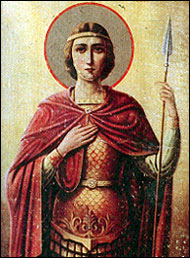|
On May 6th (April 23rd by the old calendar) we commemorate one of the greatest saints of the Christian Church – the Great-Martyr Saint George.
St. George served in the Roman army of Emperor Diocletian (284-305 A.D.), and for his bravery in battle the Emperor awarded him great honors and a high military rank. However, when Diocletian embarked upon a harsh persecution of Christians, St. George, who had been raised a Christian from childhood, bravely stood before the Emperor and confessed his faith in the Lord Jesus Christ. The Emperor ordered St. George to be extensively and severely tortured, which the soldier of Christ bore with his usual courage and humble prayer to God. For this the Lord healed his wounds, so that after every torture the saint again appeared whole and sound. This and other miracles caused many people to believe in Christ. When even the Emperor’s wife, Queen Alexandra, confessed her belief in Christ, Diocletian ordered St. George to be beheaded.
|

Great-martyr St.George
|
|
Even after his death the holy martyr performed many miracles. One of his greatest miracles was the deliverance of the inhabitants of the city of Beirut from a fierce dragon. This terrible monster lived in a lake near Beirut, nor far from the mountains of Lebanon. Emerging from the lake, the monster abducted many people and devoured them. The inhabitants of the city, who were idol-worshippers, armed themselves many times and battled the dragon, but the latter filled the air with the fumes of his poisonous breath, from which many people died. Finally the people of Beirut came to their king and asked him for help. The king promised to find out the will of the gods. He turned to the idols, but the demons who lived inside these idols, wishing to destroy the people, incited the king to announce the following: every day the inhabitants of Beirut must draw lots and feed one of their children to the dragon; and the king agreed, when his turn came, to give up his daughter too.
|
|
And so it was that every day the people of Beirut drew lots and, dressing up one of their sons or daughters in their best clothes, would take them to the lake and leave them to be devoured by the dragon. When the king’s turn finally came, he was forced to give up his daughter, although he wept and grieved for her, since she was his only child. The princess was dressed up too, and left at the usual place on the shores of the lake. But at that moment, by God’s providence, which desired to save the inhabitants of Beirut from both physical and spiritual destruction, the Great-martyr St. George, carrying a spear, rode up on his horse. The terrified princess begged him to leave immediately, so that he would not perish, but when he learned of the dragon, St. George promised her that he would save her in the Lord’s name. At that moment the terrible monster emerged from the lake and approached his victim. The princess screamed, while St. George, making the sign of the cross and rattling his spear, rushed at the dragon, struck his throat with great force and pinned him to the ground. Then St. George ordered the princess to tie up the dragon with her sash and lead the now submissive monster into the city. After-wards St. George killed the dragon with his sword in the middle of town. Seeing such a miracle, all the inhabitants of the city came to believe in Christ, and 25,000 people were baptized at that time, not counting women and children.
|

The great-martyr St. George with the dragon.
16th century icon of the Novogorod school.
|
|
Russian people have always venerated St. George greatly as a patron saint of agriculture and protector of flocks and shepherds, because the saint often provided help, appearing on his white horse. Also, on the basis of the miracle with the dragon, the image of St. George was incorporated into the Russian imperial coat-of-arms as a symbol of victory, and was also made into a special medal with which Russian Orthodox soldiers were decorated for valor in combat, since from ancient times St. George was venerated in Russia as the heavenly protector of princes and soldiers. The order of St. George – a cross and a star – was established in his honor by Empress Catherine the Great. The order had four degrees. The crosses of all four degrees differed only in size. They were made of gold covered with white enamel, with a gold border along the edges. In the middle of the cross there was a circle covered with red enamel, containing an image of St. George on his horse, vanquishing the dragon with his spear.
|
|